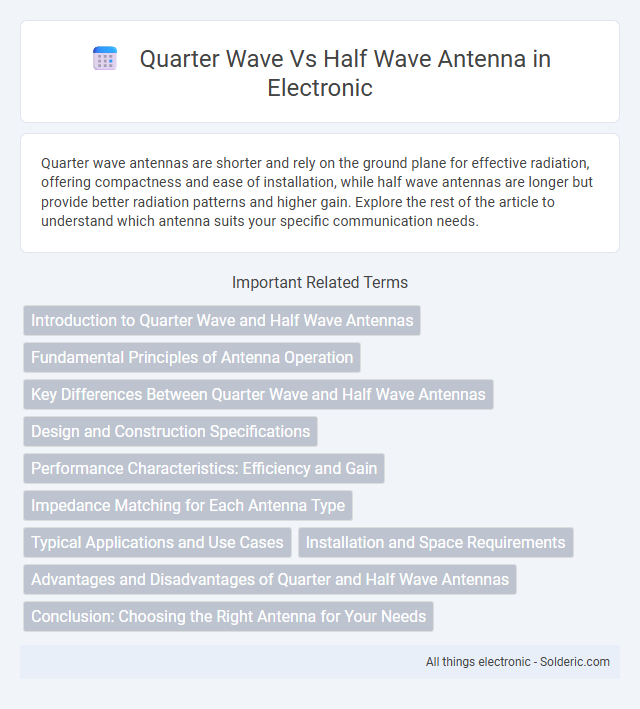Quarter wave antennas are shorter and rely on the ground plane for effective radiation, offering compactness and ease of installation, while half wave antennas are longer but provide better radiation patterns and higher gain. Explore the rest of the article to understand which antenna suits your specific communication needs.
Comparison Table
| Feature | Quarter Wave Antenna | Half Wave Antenna |
|---|---|---|
| Length | 1/4 wavelength | 1/2 wavelength |
| Size | Smaller, compact design | Larger, requires more space |
| Radiation Pattern | Omnidirectional, vertically polarized | Omnidirectional with higher gain |
| Impedance | ~36.5 ohms | ~73 ohms |
| Gain | Lower gain (around 2-5 dBi) | Higher gain (around 5-7 dBi) |
| Bandwidth | Narrower bandwidth | Wider bandwidth |
| Feed Point | Requires ground plane | Does not require ground plane |
| Applications | Mobile radios, base stations with space constraints | Broadcasting, HF communication, ham radio antennas |
Introduction to Quarter Wave and Half Wave Antennas
Quarter wave antennas are designed to be one-fourth the wavelength of the signal they transmit or receive, making them compact and efficient for various applications. Half wave antennas measure half the wavelength, typically providing better gain and directivity due to their larger size. Understanding these fundamental differences helps you choose the right antenna for your communication system's performance and spatial constraints.
Fundamental Principles of Antenna Operation
Quarter wave antennas operate by utilizing a length equal to one-fourth of the signal wavelength, exploiting the relationship between wavelength and resonance to efficiently radiate or receive radio waves. Half wave antennas, measuring half the signal wavelength, form a standing wave with a voltage node and current antinode at the feed point, maximizing energy transfer and radiation efficiency. Both antenna types leverage the electromagnetic wave properties and resonance to achieve optimal impedance matching and maximize signal radiation or reception within their respective frequency bands.
Key Differences Between Quarter Wave and Half Wave Antennas
Quarter wave antennas are typically shorter, measuring approximately one-quarter of the wavelength, whereas half wave antennas span about half the wavelength, resulting in different size requirements and installation constraints. Half wave antennas generally exhibit higher gain and better radiation efficiency due to their longer effective length, making them suitable for applications requiring stronger signal transmission. Quarter wave antennas offer simpler design and easier matching to feed lines, providing a compact solution with slightly lower performance compared to half wave counterparts.
Design and Construction Specifications
Quarter wave antennas require a conductive element approximately one-quarter of the wavelength and a ground plane or counterpoise for effective operation, resulting in simpler and more compact designs. Half wave antennas consist of a single element about half the wavelength long and do not rely heavily on a ground plane, providing higher gain and better radiation efficiency but with increased size and construction complexity. Both designs demand precision in element length and material selection to optimize frequency response and minimize signal loss.
Performance Characteristics: Efficiency and Gain
Quarter wave antennas offer moderate efficiency and gain, making them suitable for compact installations with limited space, typically providing around 2 dB gain. Half wave antennas deliver higher efficiency and gain, often exceeding 3 dB, due to their longer element length that better captures and radiates RF energy. Your choice between the two should consider the desired balance of antenna size and performance requirements for optimal signal strength.
Impedance Matching for Each Antenna Type
Quarter wave antennas typically exhibit an impedance around 36 to 50 ohms, providing a naturally better match to standard 50-ohm transmission lines and reducing the need for complex matching networks. Half wave antennas generally present an impedance near 70 to 75 ohms, which may require impedance transformation or matching components such as baluns to achieve optimal power transfer and minimize signal reflection. Proper impedance matching for both quarter wave and half wave antennas is crucial to maximize antenna efficiency and ensure effective RF performance.
Typical Applications and Use Cases
Quarter wave antennas are commonly used in mobile communication devices, walkie-talkies, and vehicle-mounted radios due to their compact size and ease of installation. Half wave antennas are preferred for base stations, broadcast transmitters, and amateur radio setups because of their higher gain and better radiation efficiency. Your choice depends on the balance between space constraints and performance requirements for the specific communication application.
Installation and Space Requirements
Quarter wave antennas require less installation space due to their shorter length, typically one-quarter of the signal's wavelength, making them ideal for compact or constrained environments. Half wave antennas, being twice as long, demand more physical room and careful mounting to avoid interference and ensure optimal signal radiation. Your choice depends on available space, with quarter wave antennas offering easier installation in tight areas while half wave antennas may provide better performance when space allows.
Advantages and Disadvantages of Quarter and Half Wave Antennas
Quarter wave antennas offer a compact size, making them easier to install in limited spaces, but they typically provide lower gain and narrower bandwidth compared to half wave antennas. Half wave antennas deliver higher gain and broader bandwidth, enhancing signal strength and quality, though their larger size can be less practical for portable or space-constrained applications. Your choice depends on the balance between size constraints and performance needs, where quarter wave antennas excel in portability and half wave antennas in efficiency.
Conclusion: Choosing the Right Antenna for Your Needs
Quarter wave antennas offer a compact size and ease of installation, making them ideal for space-constrained applications and mobile setups. Half wave antennas provide higher gain and better radiation efficiency, suitable for fixed installations requiring stronger signal coverage and longer range. Your choice should balance physical space, desired performance, and application specifics to optimize connectivity and overall communication quality.
quarter wave vs half wave antenna Infographic

 solderic.com
solderic.com